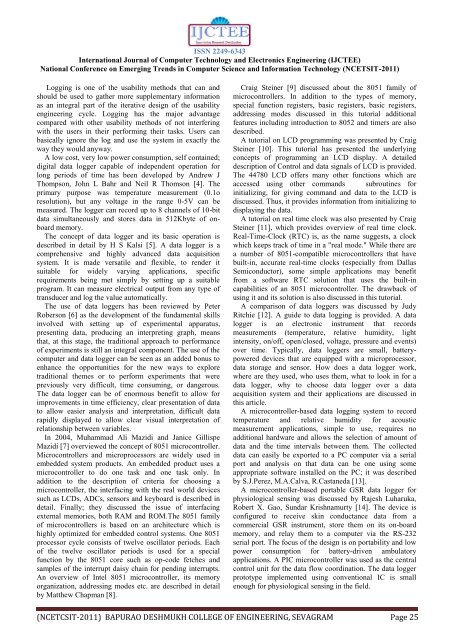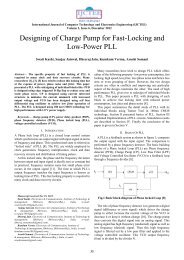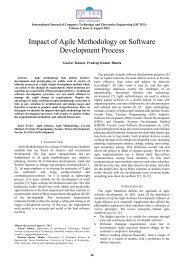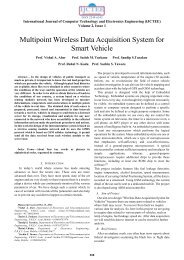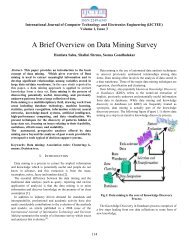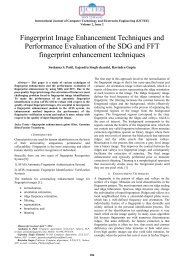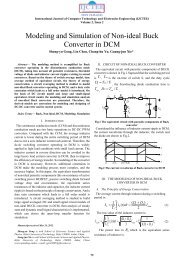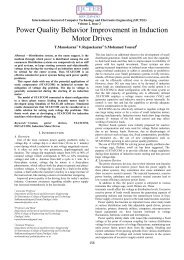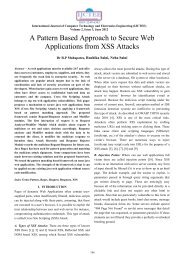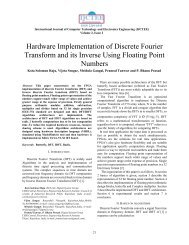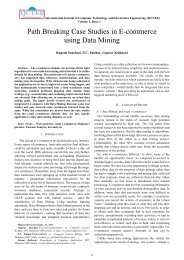Data Logger System: A Survey - International Journal of Computer ...
Data Logger System: A Survey - International Journal of Computer ...
Data Logger System: A Survey - International Journal of Computer ...
You also want an ePaper? Increase the reach of your titles
YUMPU automatically turns print PDFs into web optimized ePapers that Google loves.
ISSN 2249-6343<strong>International</strong> <strong>Journal</strong> <strong>of</strong> <strong>Computer</strong> Technology and Electronics Engineering (IJCTEE)National Conference on Emerging Trends in <strong>Computer</strong> Science and Information Technology (NCETSIT-2011)Logging is one <strong>of</strong> the usability methods that can andshould be used to gather more supplementary informationas an integral part <strong>of</strong> the iterative design <strong>of</strong> the usabilityengineering cycle. Logging has the major advantagecompared with other usability methods <strong>of</strong> not interferingwith the users in their performing their tasks. Users canbasically ignore the log and use the system in exactly theway they would anyway.A low cost, very low power consumption, self contained;digital data logger capable <strong>of</strong> independent operation forlong periods <strong>of</strong> time has been developed by Andrew JThompson, John L Bahr and Neil R Thomson [4]. Theprimary purpose was temperature measurement (0.1oresolution), but any voltage in the range 0-5V can bemeasured. The logger can record up to 8 channels <strong>of</strong> 10-bitdata simultaneously and stores data in 512Kbyte <strong>of</strong> onboardmemory.The concept <strong>of</strong> data logger and its basic operation isdescribed in detail by H S Kalsi [5]. A data logger is acomprehensive and highly advanced data acquisitionsystem. It is made versatile and flexible, to render itsuitable for widely varying applications, specificrequirements being met simply by setting up a suitableprogram. It can measure electrical output from any type <strong>of</strong>transducer and log the value automatically.The use <strong>of</strong> data loggers has been reviewed by PeterRoberson [6] as the development <strong>of</strong> the fundamental skillsinvolved with setting up <strong>of</strong> experimental apparatus,presenting data, producing an interpreting graph, meansthat, at this stage, the traditional approach to performance<strong>of</strong> experiments is still an integral component. The use <strong>of</strong> thecomputer and data logger can be seen as an added bonus toenhance the opportunities for the new ways to exploretraditional themes or to perform experiments that werepreviously very difficult, time consuming, or dangerous.The data logger can be <strong>of</strong> enormous benefit to allow forimprovements in time efficiency, clear presentation <strong>of</strong> datato allow easier analysis and interpretation, difficult datarapidly displayed to allow clear visual interpretation <strong>of</strong>relationship between variables.In 2004, Muhammad Ali Mazidi and Janice GillispeMazidi [7] overviewed the concept <strong>of</strong> 8051 microcontroller.Microcontrollers and microprocessors are widely used inembedded system products. An embedded product uses amicrocontroller to do one task and one task only. Inaddition to the description <strong>of</strong> criteria for choosing amicrocontroller, the interfacing with the real world devicessuch as LCDs, ADCs, sensors and keyboard is described indetail. Finally; they discussed the issue <strong>of</strong> interfacingexternal memories, both RAM and ROM.The 8051 family<strong>of</strong> microcontrollers is based on an architecture which ishighly optimized for embedded control systems. One 8051processor cycle consists <strong>of</strong> twelve oscillator periods. Each<strong>of</strong> the twelve oscillator periods is used for a specialfunction by the 8051 core such as op-code fetches andsamples <strong>of</strong> the interrupt daisy chain for pending interrupts.An overview <strong>of</strong> Intel 8051 microcontroller, its memoryorganization, addressing modes etc. are described in detailby Matthew Chapman [8].Craig Steiner [9] discussed about the 8051 family <strong>of</strong>microcontrollers. In addition to the types <strong>of</strong> memory,special function registers, basic registers, basic registers,addressing modes discussed in this tutorial additionalfeatures including introduction to 8052 and timers are alsodescribed.A tutorial on LCD programming was presented by CraigSteiner [10]. This tutorial has presented the underlyingconcepts <strong>of</strong> programming an LCD display. A detaileddescription <strong>of</strong> Control and data signals <strong>of</strong> LCD is provided.The 44780 LCD <strong>of</strong>fers many other functions which areaccessed using other commands subroutines forinitializing, for giving command and data to the LCD isdiscussed. Thus, it provides information from initializing todisplaying the data.A tutorial on real time clock was also presented by CraigSteiner [11], which provides overview <strong>of</strong> real time clock.Real-Time-Clock (RTC) is, as the name suggests, a clockwhich keeps track <strong>of</strong> time in a "real mode." While there area number <strong>of</strong> 8051-compatible microcontrollers that havebuilt-in, accurate real-time clocks (especially from DallasSemiconductor), some simple applications may benefitfrom a s<strong>of</strong>tware RTC solution that uses the built-incapabilities <strong>of</strong> an 8051 microcontroller. The drawback <strong>of</strong>using it and its solution is also discussed in this tutorial.A comparison <strong>of</strong> data loggers was discussed by JudyRitchie [12]. A guide to data logging is provided. A datalogger is an electronic instrument that recordsmeasurements (temperature, relative humidity, lightintensity, on/<strong>of</strong>f, open/closed, voltage, pressure and events)over time. Typically, data loggers are small, batterypowereddevices that are equipped with a microprocessor,data storage and sensor. How does a data logger work,where are they used, who uses them, what to look in for adata logger, why to choose data logger over a dataacquisition system and their applications are discussed inthis article.A microcontroller-based data logging system to recordtemperature and relative humidity for acousticmeasurement applications, simple to use, requires noadditional hardware and allows the selection <strong>of</strong> amount <strong>of</strong>data and the time intervals between them. The collecteddata can easily be exported to a PC computer via a serialport and analysis on that data can be one using someappropriate s<strong>of</strong>tware installed on the PC; it was describedby S.J.Perez, M.A.Calva, R.Castaneda [13].A microcontroller-based portable GSR data logger forphysiological sensing was discussed by Rajesh Luharuka,Robert X. Gao, Sundar Krishnamurty [14]. The device isconfigured to receive skin conductance data from acommercial GSR instrument, store them on its on-boardmemory, and relay them to a computer via the RS-232serial port. The focus <strong>of</strong> the design is on portability and lowpower consumption for battery-driven ambulatoryapplications. A PIC microcontroller was used as the centralcontrol unit for the data flow coordination. The data loggerprototype implemented using conventional IC is smallenough for physiological sensing in the field.(NCETCSIT-2011) BAPURAO DESHMUKH COLLEGE OF ENGINEERING, SEVAGRAM Page 25


